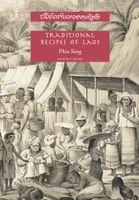Advertisement
Ginger and Galingale
By Phia Sing
Published 1981
The ginger plant, ZINGIBER OFFICINALE, is a native of Asia. The parts which are eaten (excepting the flowers, for which) are the irregular rhizomes, shown in the drawing on the right, which form just below or at the surface of the soil. Fresh ginger is normally used in Lao dishes. When slices of it are specified, these would be about as thick as a large coin. The Lao name for ginger is khing; and, in the currency of the spirit world in which many Lao believe, it is gold.

LANGUAS GALANGA (or ALPINIA GALANGA, as it is sometimes known) is galingale (or, to follow older English usage, galangal). As with ginger, it is the rhizomes which are eaten. They are a very popular ingredient in South-East Asia. The Lao name is kha, or kha ta deng (deng, red, refers to the pinkish colour of the base of the old flowering stem). The rhizomes of this plant are a little harder than those of ginger, and have a somewhat different flavour, but are used in the same way. Powdered galingale, as well as the dried rhizomes, are available in the west, often under their Indonesian name of laos (which has nothing to do with the country Laos).


